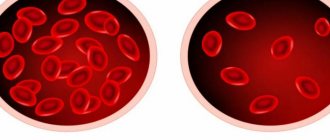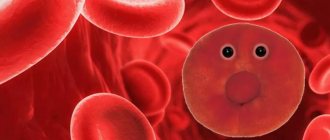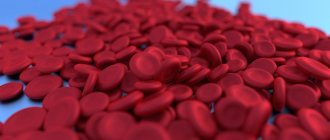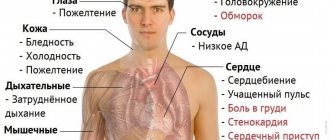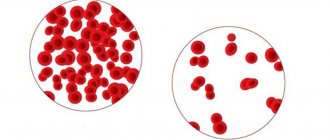Iron deficiency
9624 January 29
IMPORTANT!
The information in this section cannot be used for self-diagnosis and self-treatment.
In case of pain or other exacerbation of the disease, diagnostic tests should be prescribed only by the attending physician. To make a diagnosis and properly prescribe treatment, you should contact your doctor. We remind you that independent interpretation of the results is unacceptable, the information below is for reference only
Hemoglobin: indications for use, rules for preparing for the test, interpretation of results and normal indicators.
Indications for the purpose of the study
Hemoglobin is a complex protein, the main component of red blood cells, which carries oxygen from the lungs to all tissues of the body and is involved in the removal of carbon dioxide from the body's cells.
The hemoglobin molecule consists of heme (the non-protein part) and globin (the protein part, which contains four polypeptide chains in its molecule: two alpha chains and two beta chains). Each of the four globin subunits has a heme group with an iron atom attached to it.
Normally, several forms of hemoglobin can be found in the blood, differing from each other in the protein part (quantitative or qualitative composition of the amino acids that make up the globin):
- embryonic (occurs in the fetus up to 2 months of intrauterine development);
- fetal (formed from the 2nd month of intrauterine development, circulates before birth, is destroyed in the first week of life);
- mature hemoglobin.
When hemoglobin interacts with various substances that can bind to its active center, hemoglobin derivatives arise. Depending on what hemoglobin has attached, the following forms are distinguished:
- HbO2 – compound with oxygen (oxyhemoglobin);
- HbCO2 – hemoglobin with carbon dioxide (carbohemoglobin);
- HbMet – hemoglobin with oxidized iron (methemoglobin);
- HbCO – carboxyhemoglobin formed during carbon monoxide poisoning;
- HbA1C – glycosylated hemoglobin in diabetes mellitus.
Along with normal forms of hemoglobin, there may be mutant or pathological ones. More than 300 forms of pathological hemoglobins are known.
Most often found:
- HbS – hemoglobin in sickle cell anemia;
- Kempsey hemoglobin for polycythemia;
- hemoglobin Hammersmith et al.
Derivatives and pathological forms of hemoglobin are determined for the purpose of diagnosing various diseases and during dynamic monitoring of their course (for example, the glycosylated hemoglobin indicator reflects the average blood glucose level over the previous three months).
The lifespan of red blood cells, the dry matter of which is 90-95% hemoglobin, is 110-120 days. The destruction of red blood cells occurs in the spleen, a small part of the hemoglobin breaks down in the red bone marrow and stellate cells of the liver.
Determination of hemoglobin concentration as part of a clinical blood test is one of the most important diagnostic methods. A calculated indicator reflecting the average hemoglobin content in 1 cell (erythrocyte) is used for the differential diagnosis of anemia.
Hemoglobin concentration is determined as part of preventive, dispensary observation during the initial examination to identify diseases, during hospitalization in therapeutic and surgical hospitals.
Determination of the quantitative content of hemoglobin is used in combination with other hematological indicators (hematocrit value, number of red blood cells, red blood cell indices) to diagnose a number of pathological conditions: anemia, erythremia and secondary erythrocytosis, to assess the degree of dehydration of the body, determine the severity of blood loss in hemorrhagic conditions, and assess the effectiveness of blood transfusions in the process of therapy, determining the severity of the patient’s condition in inflammatory, infectious diseases, as well as for monitoring the therapy and the course of various diseases.
Hidden iron deficiency - how to deal with it?
I feel bad, constant weakness. I took a blood test and the doctor said it was normal. Tell me what to do...
If you get tired quickly, often suffer from acute respiratory viral infections, if you are worried about hair loss, brittle nails, dry skin, if “everything hurts, nothing helps” - it’s time to rule out iron deficiency, says OKDC doctor-therapist Tatyana Abramova
There are more and more “iron deficient” people...
Today, iron deficiency is the most common pathology. According to some reports, more than 1.5 billion people on our planet have iron deficiency. Iron deficiency anemia itself is not a disease, but it can become a symptom of a serious pathology.
The biological role of iron in the body is great - it is involved in redox processes, tissue growth and aging, immunity mechanisms, hematopoiesis, oxygen supply to organs and tissues, and the functioning of a number of enzymes.
Lack of iron and subsequent tissue and hemic hypoxia lead to significant trophic changes in hair, thinning, increased hair loss and even early greying. Along with this, brittleness of the nails, their transverse striations, jagged edges of the nails, curvature of the nail plate, flattening or concavity of the nails up to spoon-shaped appear. In this case, urinary incontinence is often observed. A perversion of taste occurs in the form of an addiction to raw meat, dough, chalk, tooth powder, etc. Patients are attracted to the smells of mold, gasoline, kerosene or acetone.
Sometimes iron deficiency leads to atrophy of the mucous membrane of the tongue, angular stomatitis, glossitis, dental caries and muscle weakness. An increase in temperature to subfebrile levels can also be a manifestation of iron deficiency.
Everything hurts...
What could be the connection between iron deficiency anemia and back pain? Imagine not getting enough sleep for several nights in a row. The body then seems sluggish, disobedient, heavy, pain appears or intensifies in those places of the spine in which it was previously felt. People suffering from chronic iron deficiency anemia experience something similar. In addition to general weakness, malaise, brittle nails and hair loss, they may also experience persistent back pain. And some complain that “everything hurts.” To understand why this happens, remember that iron deficiency anemia is characterized by a low level of hemoglobin in the blood, which is a transporter for oxygen. A person with a low hemoglobin content can breathe the purest air in a pine forest, but oxygen in the required quantity will not enter the body’s cells, because there is not enough transport - hemoglobin. In turn, oxygen is an oxidizing agent, thanks to which metabolic processes occur in cells. Not enough - they accumulate under-oxidized metabolic products, essentially poison, poisoning the body and disrupting its functioning.
Hence the weakness and lethargy, as in case of poisoning, and increased muscle fatigue. And if we take into account that nervous tissue is most sensitive to hypoxia, then the strange at first glance complaint of patients that “everything hurts” also finds an explanation.
Patients go to a neurologist, gastroenterologist or cardiologist; they have disorders of the cardiovascular system, myocardial dystrophy; vegetative-vascular and vestibular disorders occur. People suffer from frequent colds and acute respiratory infections, problems with the digestive system and kidneys. They undergo treatment for a long time, follow the instructions of specialists, but find that the expected recovery and improvement in quality of life does not exist, or they are short-lived. And all this is only because they overlooked an important one - iron deficiency. In such cases, the therapist had to conduct all the necessary research and identify the true causes of the ailment.
And there can be a lot of reasons for iron deficiency, and they are very different:
- chronic blood loss of various locations: gastrointestinal (gastroesophageal reflux disease, erosive and ulcerative lesions of the stomach, tumors of the stomach and colon, terminal ileitis, ulcerative colitis, diverticulitis, bleeding hemorrhoids);
- menstrual blood loss (menorrhagia of various etiologies, fibroids, endometrosis);
- nasal (hereditary hemorrhagic telangiectasia and other hemorrhagic diathesis);
- iron absorption disorders
- resection of the small intestine, stomach with exclusion of the duodenum;
- increased need for iron: pregnancy, lactation, intensive growth and puberty;
- impaired iron transport (hypoproteinemia of various origins);
- nutritional deficiency.
Hidden threat
The most unpleasant thing is that latent (hidden) iron deficiency is widespread among the population, when hemoglobin levels are still normal, but transport and organ reserves of iron are already depleted. This “disguised” deficit ranges from 19.5 to 30%. In addition, 50 to 86% of women in various populations have risk factors for anemia. Therefore, the Regional Consultative and Diagnostic Center has introduced the most modern methods for identifying hidden processes of changes in blood composition and early diagnosis of iron deficiency conditions.
Therapists from the OKDC will always help you to clarify the causes of the development of anemia and iron deficiency, select the right set of diagnostic laboratory tests, and understand the causes of the pathology.
share information
0
Social buttons for Joomla
Preparation for the procedure
- It is recommended to donate blood in the morning from 8 to 11 o’clock, on an empty stomach (at least 8 hours of fasting, you can drink water as usual).
- Tell your doctor about the medications you are taking.
- Avoid drinking alcohol on the eve of the test and do not smoke for 1 hour before the test.
- Avoid physical and emotional stress on the eve of the study.
- After arriving at the laboratory, rest for 10-20 minutes before drawing blood.
- It is not advisable to donate blood for laboratory testing soon after physiotherapeutic procedures, instrumental examinations and other medical interventions.
- When monitoring laboratory parameters over time, it is recommended to conduct repeated studies under the same conditions: in the same laboratory (using the same method), at approximately the same time of day, etc.
Reasons for decreased hemoglobin
Hemoglobin in the blood can decrease for various reasons. Among the main factors that can provoke a lack of iron-containing protein, doctors identify:
Advertising:
- unbalanced diet with insufficient amounts of foods containing iron;
- excessively heavy or prolonged periods;
- abortion, childbirth or surgery accompanied by significant blood loss;
- hemorrhoids with bleeding;
- following a strict diet or fasting;
- diseases of the hematopoietic system;
- disruption of the absorption of iron in the intestinal cavity;
- lack of vitamin B12, necessary for the formation of hemoglobin in the body.
Common causes of iron deficiency anemia are diseases of the digestive system - chronic enteritis or atrophic gastritis, leukemia, benign or malignant neoplasms in the body.
The causes of a rapid decrease in hemoglobin levels can also be autoimmune and long-term infectious diseases - rheumatoid arthritis, systemic lupus erythematosus, tuberculosis, pneumonia, hepatitis. Many factors can cause the development of anemia; the exact cause can only be determined after a medical examination.
Types of glucometers
The classification is based on the operating principle of the device. Devices for measuring blood sugar levels are divided into invasive and non-invasive. The first involves pricking a finger and collecting capillary blood. They are:
- photometric;
- electrochemical;
- coulometric.
Express test strips are considered separately from invasive glucometers. This is not a device, but rather an indicator of sugar content. Although you also need to pierce your finger to use it.
For children and elderly patients, it is more convenient to use non-invasive ones. They do not require blood for analysis, so the measurement is absolutely painless. This category includes sensor devices (or Raman devices), including laser ones. They determine glucose levels based on subjective factors, so their accuracy is somewhat lower.
Coulometric glucometers
This is a type of electrochemical meters. The principle of determining glucose concentration is similar to amperometric. Only in this case, it is not the current strength that is assessed, but the electric charge. The required volume of blood for analysis is minimal compared to all other devices.
Amperometric instruments are more often used in laboratory practice, while coulometric instruments are usually used for home use.
The two subtypes differ in the price of consumables. Patients with type 1 diabetes need to measure their glucose more often. Therefore, it is more profitable for them to acquire an amperometric device with cheaper test strips. Coulometric tests are recommended for the control of type 2 diabetes.
A few words about the role of hemoglobin
The hemoglobin level plays a very important role in the full functioning of the human body. This iron-containing protein supplies oxygen to the cells and tissues of internal organs, ensuring their normal functioning.
You can increase your hemoglobin level if it decreases with the help of a proper, balanced diet. Additionally, you can take pharmaceutical iron supplements, which will be prescribed by your doctor based on the results of a blood test.
How to choose the right glucometer
You can see many models on the market. Equally high-quality devices differ in the degree of convenience for a particular user. You can understand which glucometer is best to buy for your home by answering a few questions:
- Which type of device is most convenient for you?
- Does the required blood volume matter? For the elderly, children and especially sensitive people, the depth of the puncture is important.
- Is measurement time important? Faster ones cost more, but not everyone needs them.
- What test strips are available in pharmacies near you?
- Is additional plasma calibration required? In simpler devices it is carried out through capillary blood.
- How much memory is needed? This determines how many last measurements can be recorded.
It is important to decide whether additional features are needed. Modern sugar meters can have a lot of them. But their presence is not necessary.
Hemoglobin measurement with portable rapid tests
To measure hemoglobin levels at home, you can use simple and convenient test strips. Many manufacturers offer functional portable blood analyzers that measure not only iron protein levels, but also blood sugar and cholesterol. To do this you need to follow a few simple steps:
- wash your hands thoroughly;
- sit down and try to relax;
- Shake your hand for 2-3 seconds to activate blood circulation in your hand;
- lubricate your finger with alcohol;
- install the test strip with a connector specially designated for it - the device turns on in automatic mode;
- The device comes with a special pen with a needle, with which you need to puncture the treated finger;
- Apply a drop of blood from your finger to the control field of the strip.
Within a few seconds, information about the level of hemoglobin in the blood will appear on the device monitor. Many such devices are equipped with an electronic memory function, which allows them to record the obtained analysis result.
Photometric glucometers
These devices read the change in color of a test strip onto which the patient's blood is applied. Such strips are coated with a reagent containing glucose oxidase. It gives specific responses to a particular level of glucose concentration, coloring the strip in the appropriate color.
You don't have to compare colors yourself. The scale is already stored in the device's memory. When a test strip is inserted into it, it compares its color with the values on this scale and produces a numerical result.
Such devices are easy to use, but quickly break down. In addition, their optical system is so fragile that there is a high probability of breaking the glucometer during operation. And if the lens becomes cloudy, the results may be distorted.



